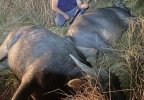Gday willybuck
Interesting in a good way & thanks for sharing sir
On your choice of copper pills here's a little to digest
On the mushroom monos overall you need to keep speed up a bit more to get a consistent kill not saying they won't kill it's the speed they kill that concerns me especially below 2100 impact & I tried to keep them above the 2300/2400 mark
I also found once the petals were shed on some these pills brands due to meplat shape erratic terminal paths were observed in some critters & angles & this can / does cause issues especially bigger critters as in the smaller critters like whitetail size usually the pills exited before the turn would have happened
overall with what you mentioned on increasing pill weight as animal size increases is pretty sound as it stops those petals from shedding
We use to use this same thought on our asiatic buff & that 200 gr pill was great as once you shed the petals on bovine ( still have with a 200 gr but that's in scrubbies )
Your killing speed is compromised
We ended up going a different route as the results are improved from our once standard on these big guys & have run from the 120 to 180 ish ( twist limited back then ) weight of the shedding petal mono & we were surprised @ the penertration & wound channels with the impact to tip extremely impressive
View attachment 426565
These 2 were taken with a 151 gr shedding petal variety & they outperformed the 200 gr mushroom in every way in the ranges they are usually hunted @
The shedding petal design has a lower velocity working range & depending on the brand this seems to be in the realm of 1750 to 1900 for the majority (2300/2400 is the worst I've found with one brand ) with this being effective killing not just a pill opening or shedding , this isn't set in stone as new types coming out potentially will push this envelope but overall I don't personally think they can much lower but always willing to eat my words & hope they prove me wrong
yes some brands will open & shed way lower but they are crap on the whole & a frangible is a way better bet if your impacting below 1750 & the upper end is pushed a bit more than the petal variety & some higher than others here also
This In turn gives us a bigger velocity window to take our game @ yet some may never reach ea end of that & in the middle somewhere which is cool & pretty safe bet
Really no different than what you described with the corelox & every other pill regardless of type but that's only one part of killing efficiency but it's fairly sound from what I've witnessed especially good shot placement
Move to varying angles/ resistances now that's the rabbit hole that's turned into a warren for me & one that really sorts pills out on a useable velocity window



